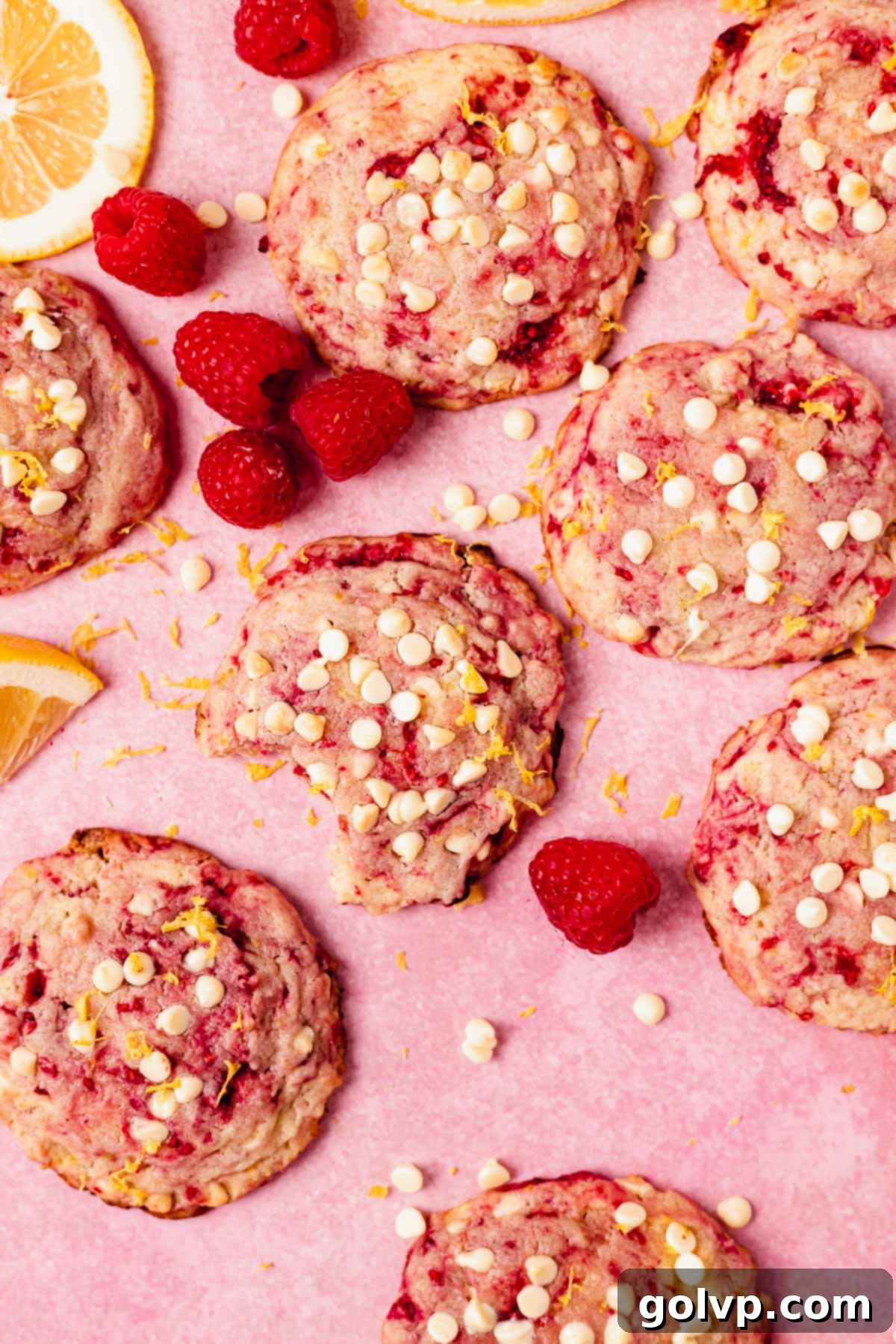Irresistible Lemon Raspberry White Chocolate Cookies: An Easy No-Chill Recipe
Prepare to fall in love with these delightful lemon raspberry cookies, a perfect blend of zesty lemon, tart raspberries, and sweet white chocolate. This recipe delivers cookies with wonderfully buttery, crisp edges and incredibly soft, chewy centers, each bite bursting with bright, refreshing flavor and delightful pockets of creamy white chocolate. What makes this recipe truly special is its incredible ease: you don’t need an electric mixer, everything comes together in just one bowl, and there’s absolutely no chilling required. This means you can whip up a batch of these cheerful treats in no time, making them the ideal dessert to brighten up any spring or summer day. Whether you’re a seasoned baker or just starting out, you’ll find joy in creating these vibrant, flavor-packed cookies that are perfect for sharing or savoring all by yourself. The unique combination of citrus and berry creates an explosion of taste that will have everyone reaching for more.
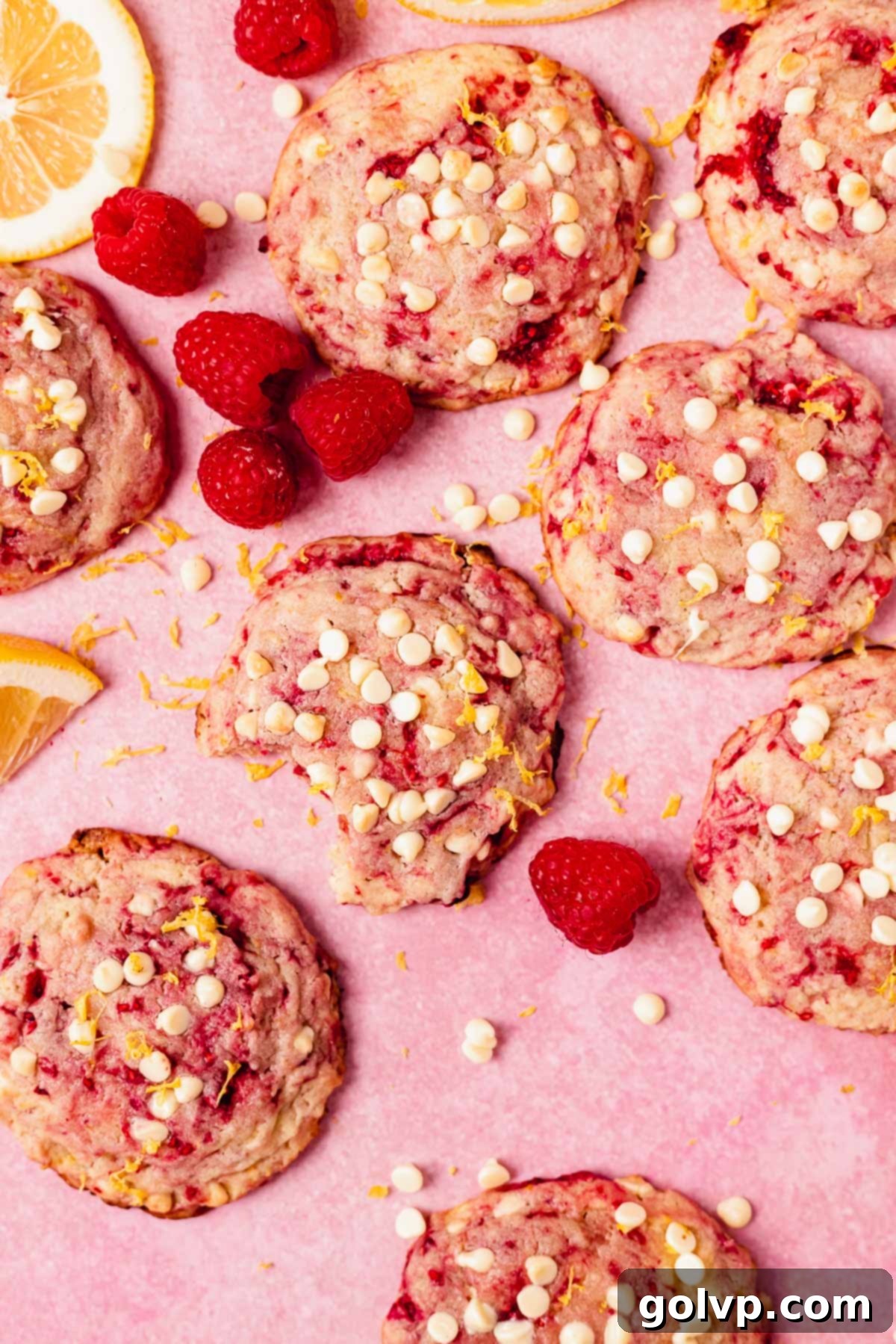
Jump to Recipe:
- Why You’ll Love It
- Key Ingredients
- Substitutions
- How to Make
- Expert Tips
- Make Ahead & Storage
- Can You Chill The Dough?
- FAQs
- Full Recipe Card
🍪 Why You’ll Absolutely LOVE This Lemon Raspberry Cookie Recipe
These lemon raspberry cookies aren’t just delicious; they’re also incredibly rewarding to bake, especially when you consider how effortlessly they come together. Here’s why this recipe will quickly become one of your favorites, whether you’re a baking novice or a seasoned pro looking for a quick and satisfying treat:
- Effortlessly Easy & No-Fuss: Forget about complex baking processes and endless cleanup! This recipe is specifically designed for maximum convenience. You won’t need an electric mixer – a simple whisk and spatula are all the tools you’ll require. All the ingredients combine beautifully in a single bowl, significantly minimizing dirty dishes. Perhaps the best part for impatient bakers: there’s absolutely no chilling required! This means you can go from craving to enjoying these fresh-baked cookies in under 30 minutes, making it a perfect last-minute dessert or snack for busy days.
- Perfect Chewy Texture with Crisp Edges: Experience the best of both worlds with a cookie that boasts delightfully crisp, golden-brown edges and a wonderfully soft, moist, and chewy middle. This exquisite contrast in texture makes each bite a dream, ensuring these cookies aren’t just flavorful but also incredibly satisfying to eat. They manage to hold their shape perfectly while delivering that comforting, melt-in-your-mouth chewiness that everyone adores in a good cookie.
- Zesty, Tangy, and Bright Flavor Burst: These cookies are a true celebration of vibrant flavors, making them an ideal choice for warmer months. They are generously packed with fresh lemon zest, which infuses the dough with an aromatic, bright citrus note that awakens the palate. The addition of frozen raspberries brings a lovely tartness and juicy bursts of fruit, perfectly balancing the sweetness of the cookie dough and the richness of white chocolate. It’s a refreshing and invigorating flavor profile that truly captures the essence of spring and summer in every bite.
- Creamy White Chocolate Pockets (Optional, but Highly Recommended!): While optional, the inclusion of good quality white chocolate chips elevates these cookies to another level of indulgence. As they bake and melt, they create luscious pockets of creamy sweetness that beautifully complement the tart raspberries and zesty lemon. The white chocolate adds a rich, luxurious dimension and a delightful textural contrast, making these cookies even more irresistible and a little more decadent.

📝 Key Ingredients for Perfect Lemon Raspberry Cookies
Crafting the perfect batch of these lemon raspberry cookies relies on selecting and preparing a few key ingredients carefully. Understanding the role of each component will lead to baking success! Read through for all the tips you will need for success!
Full steps and ingredients can be found in the comprehensive recipe card below.

- Frozen Raspberries: This is a crucial ingredient choice for this recipe. Frozen raspberries are highly preferred over fresh ones because they maintain their structural integrity much better when gently folded into the cookie dough. More importantly, they release their juices more slowly and in a more controlled manner during baking. This prevents the dough from becoming overly wet and ensures you get beautiful, distinct pockets and vibrant swirls of raspberry flavor throughout your cookies, rather than a uniformly pink, soggy dough. Avoid using fresh raspberries, as their naturally high moisture content can compromise the dough’s consistency and lead to a less desirable, potentially crumbly or cakey texture.
- High-Quality White Chocolate Chips: The type and quality of white chocolate you use can significantly impact both the flavor and creamy texture of your finished cookies. For the best results, opt for good quality white chocolate chips or, even better, a chopped white chocolate bar. Look for “real” white chocolate that lists cocoa butter as a primary ingredient, as this ensures a smoother melt and richer, creamier flavor. I personally recommend using mini white chocolate chips for optimal distribution, ensuring you get perfect little pockets of sweetness and a delightful contrast in every single bite.
- Fresh Lemons: You will need two medium-sized, bright yellow lemons for this recipe. We utilize both the zest and a touch of fresh juice. The zest is where the vast majority of the lemon’s essential oils and intense aromatic flavor reside, so make sure to zest generously, taking care to only remove the bright yellow outer layer and avoid the bitter white pith beneath. Freshly squeezed lemon juice not only adds another layer of bright, tangy flavor but also helps to balance the sweetness of the cookie dough.
- Melted and Cooled Unsalted Butter: Using melted, then cooled, unsalted butter is a key technique for achieving the signature buttery crisp edges and wonderfully soft, chewy middles that define these cookies. The melted state of the butter helps to distribute the fats more evenly throughout the dough, contributing to the distinct texture profile. It’s absolutely vital to ensure the butter is cooled to room temperature before incorporating it; hot butter can inadvertently “cook” the eggs in your dough, leading to a scrambled egg texture and an undesirable final consistency. Unsalted butter gives you precise control over the overall salt content in your recipe.
- All-Purpose Flour: For consistent and accurate baking results every single time, weighing your all-purpose flour using a kitchen scale is highly recommended (270 grams for 2 ¼ cups). This method provides the most precise measurement and helps prevent the common mistake of accidentally adding too much flour, which can lead to dense, dry, or crumbly cookies. If you don’t have a kitchen scale, you can still measure properly by first stirring the flour in its bag or container to aerate it. Then, gently spoon the flour into your dry measuring cup without packing it down, and finally, level off the excess with the flat edge of a knife.
✔️ Ingredient Substitutions & Variations for Lemon Raspberry Cookies
While this recipe is carefully crafted for optimal taste and texture, sometimes you might find yourself needing a substitution or wanting to explore a slight variation to suit dietary needs or simply to try something new. Here are some tested and recommended adjustments to make these cookies your own:
- Frozen Raspberries: As highlighted in the key ingredients section, frozen raspberries are highly recommended due to their ability to maintain shape and release moisture slowly, which is crucial for the cookie dough’s consistency. Using fresh raspberries is generally not advised because they tend to break down too easily when folded into the dough and release too much liquid too quickly. This excess moisture can potentially make your cookie dough overly wet and significantly alter the final texture, leading to a less desirable, often soggy, cookie.
- Other Berries: If you’re looking to experiment with different fruit flavors, the key is to select berries that are not overly juicy. Frozen wild blueberries are a fantastic alternative, as they are smaller and tend to hold their shape remarkably well, offering a similar burst of tart fruit. Other firm, less watery berries could potentially work, but always consider their moisture content. However, I highly recommend against using strawberries; they contain a very high amount of moisture that would almost certainly make the dough too wet and difficult to handle, resulting in a soggy, underbaked cookie.
- Dairy-Free Option: To make these delightful cookies suitable for a dairy-free diet, you can easily substitute the unsalted butter with a high-quality dairy-free butter substitute. Be sure to choose a brand that is specifically known for its performance in baking and avoid soft margarines, which might be too soft and lead to excessive cookie spreading. For the white chocolate component, simply use your favorite brand of dairy-free white chocolate chips or a chopped dairy-free white chocolate bar.
- Plain Lemon Cookies: If you’re a devoted fan of lemon but prefer to omit the raspberries for a purely citrusy treat, you can easily adapt this recipe. For a fantastic, equally simple, and delightfully no-chill lemon-only version, we highly recommend checking out our dedicated recipe for Lemon White Chocolate Cookies. These offer all the bright, zesty lemon flavor with creamy white chocolate goodness, without the fruit, and are just as easy to make.
👩🍳 How to Make These Zesty Lemon Raspberry Cookies
Follow these straightforward, step-by-step instructions to create your perfect batch of lemon raspberry cookies. The entire process is designed to be hassle-free, rewarding you with delicious results every time!
Prep: Before you begin mixing, ensure your oven is properly preheated to 355°F (180°C). Prepare a large cookie sheet by lining it with parchment paper. This crucial step prevents the cookies from sticking, promotes even baking, and makes cleanup incredibly easy.
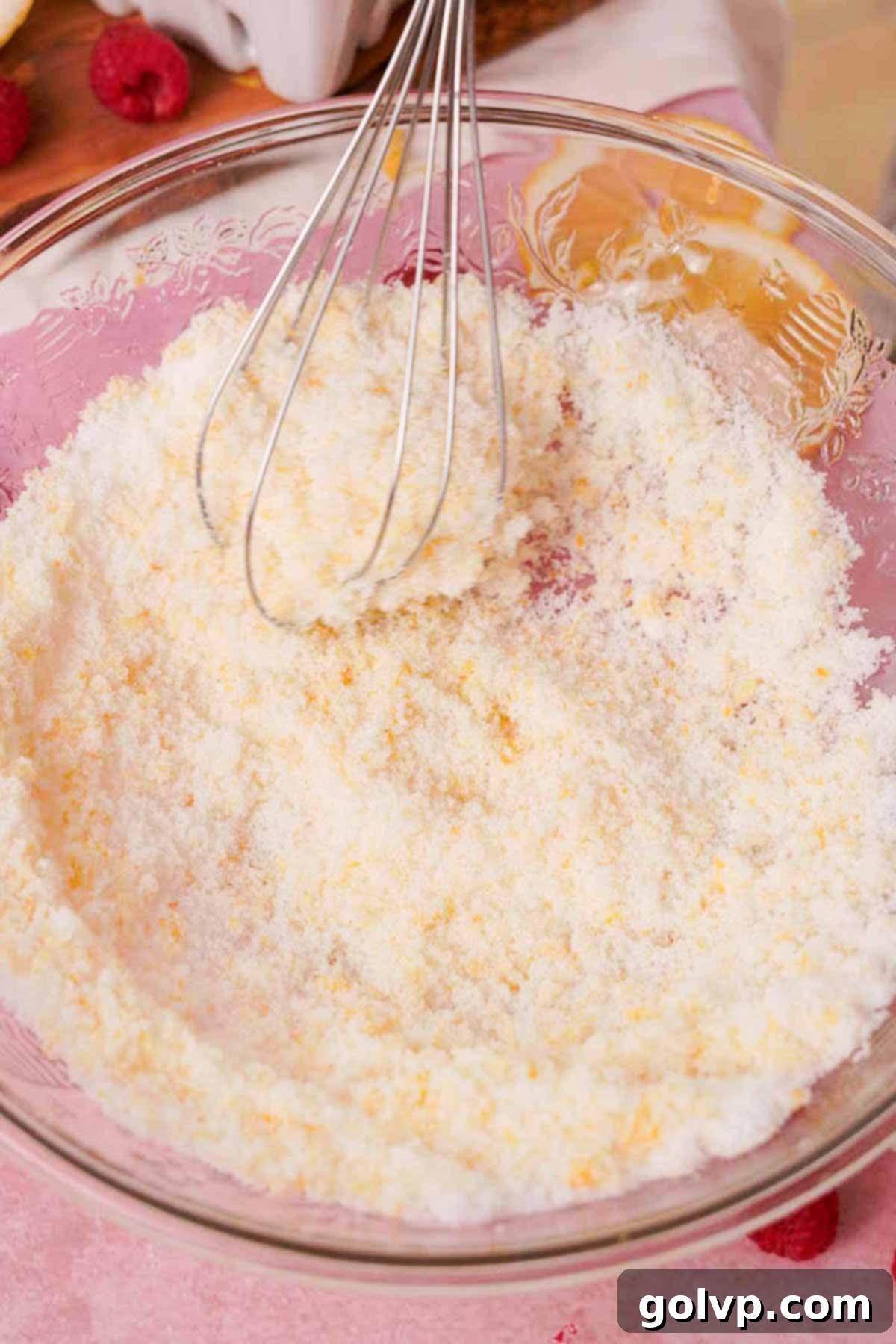
Step 1: Infuse the Sugar with Lemon Zest. Begin by zesting both lemons directly into a large mixing bowl. Add the granulated sugar to the bowl with the zest. Using a whisk or your fingertips, vigorously rub the lemon zest into the sugar until the sugar becomes noticeably fragrant, releasing a wonderful citrus aroma, and appears slightly moistened by the lemon’s essential oils. This crucial technique ensures a deep, bright lemon flavor permeates every cookie.
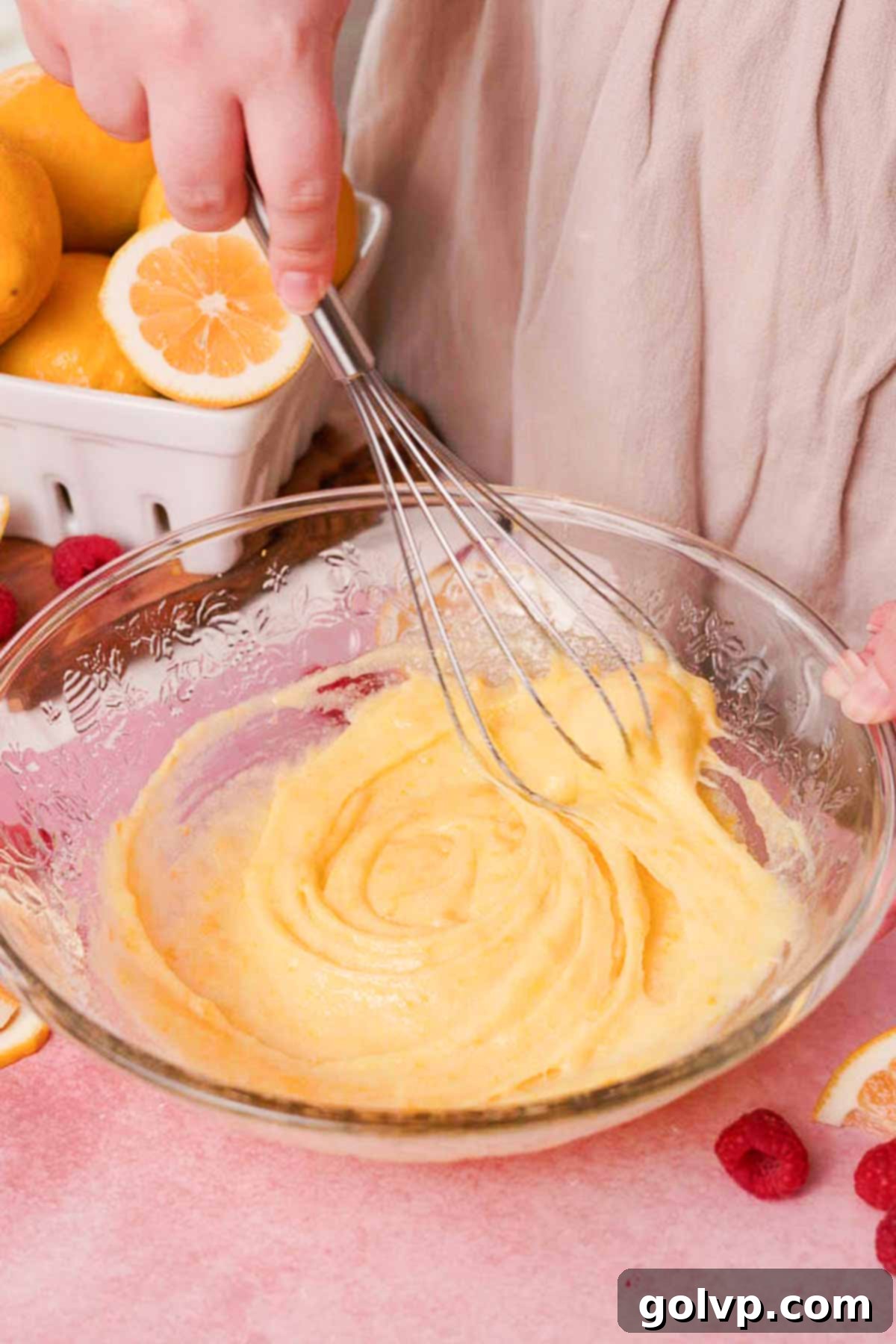
Step 2: Create a Ribbony Egg and Sugar Base. To the lemon-infused sugar, add the large egg and the additional large egg yolk. Whisk vigorously by hand for approximately 30 seconds. Continue whisking until the mixture visibly thickens, lightens in color, and increases slightly in volume. When you lift the whisk, the mixture should fall back into the bowl in slow, distinct ribbons, indicating proper aeration and emulsification – a key to chewy cookies.
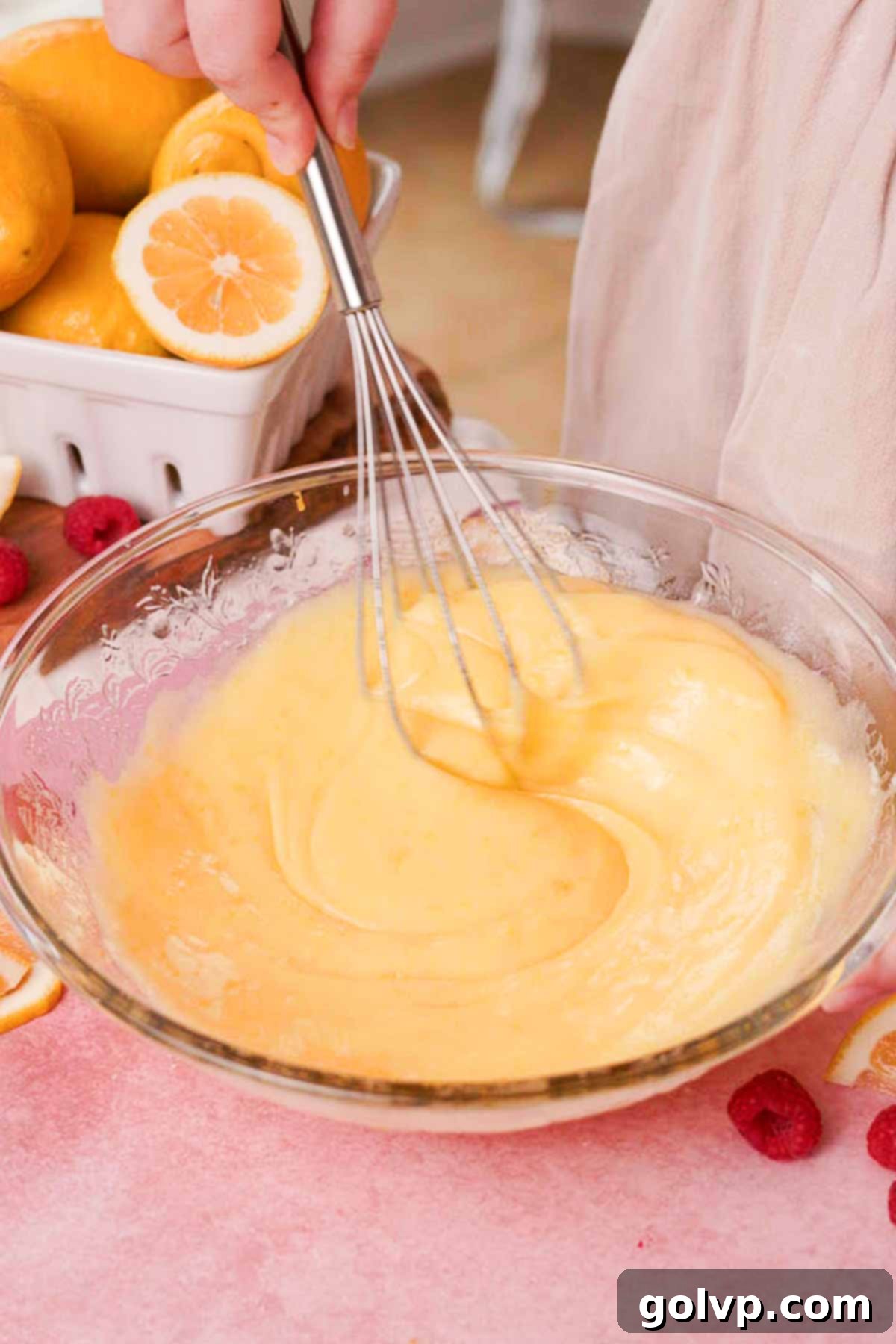
Step 3: Incorporate Butter, Salt, and Lemon Juice. Gently pour the room temperature melted butter into the same bowl with the egg mixture. Whisk just until the butter is fully incorporated and the entire mixture appears thick and smooth. Next, add the sea salt and the freshly squeezed lemon juice, whisking briefly once more to combine all these flavors evenly. It’s crucial that the butter is not hot, as this could unintentionally “cook” the eggs and compromise the dough’s texture.
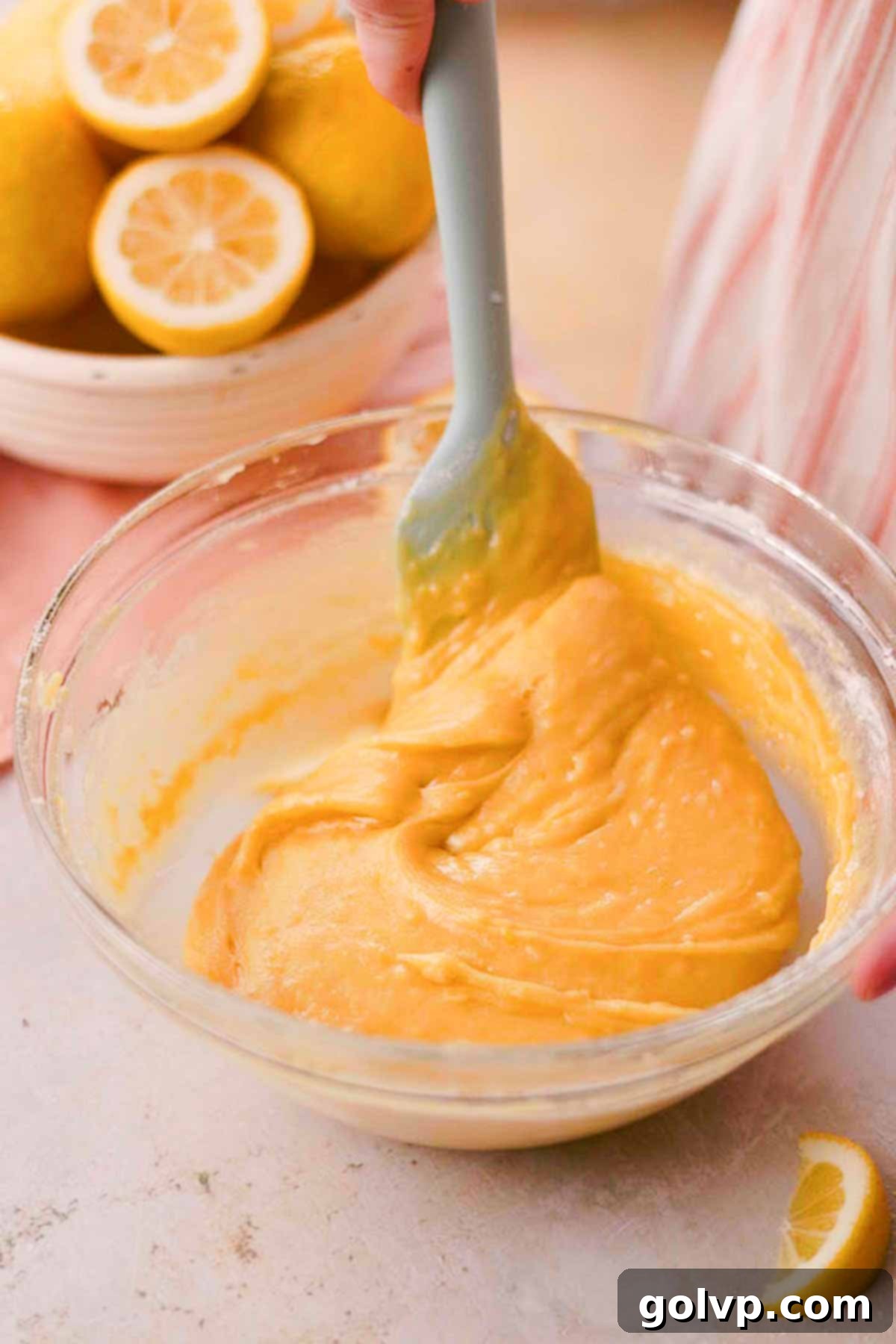
Step 4: Add the Dry Ingredients. Sift the all-purpose flour and baking soda directly over the wet ingredients in your bowl. Using a sturdy spatula, gently fold the dry ingredients into the wet mixture. Continue folding just until no dry streaks of flour are visible. It is very important not to overmix at this stage, as excessive mixing develops gluten, which can lead to dense, tough cookies instead of the desired tender chew.

Step 5: Fold in Raspberries and White Chocolate. Now it’s time to add the star ingredients! Add approximately ½ cup of your white chocolate chips to the dough (remember to reserve the remaining ½ cup for topping the baked cookies later). Take your frozen raspberries and gently crumble them into smaller, manageable pieces directly into the cookie dough. This technique helps ensure even distribution and prevents large, icy chunks in the final product.
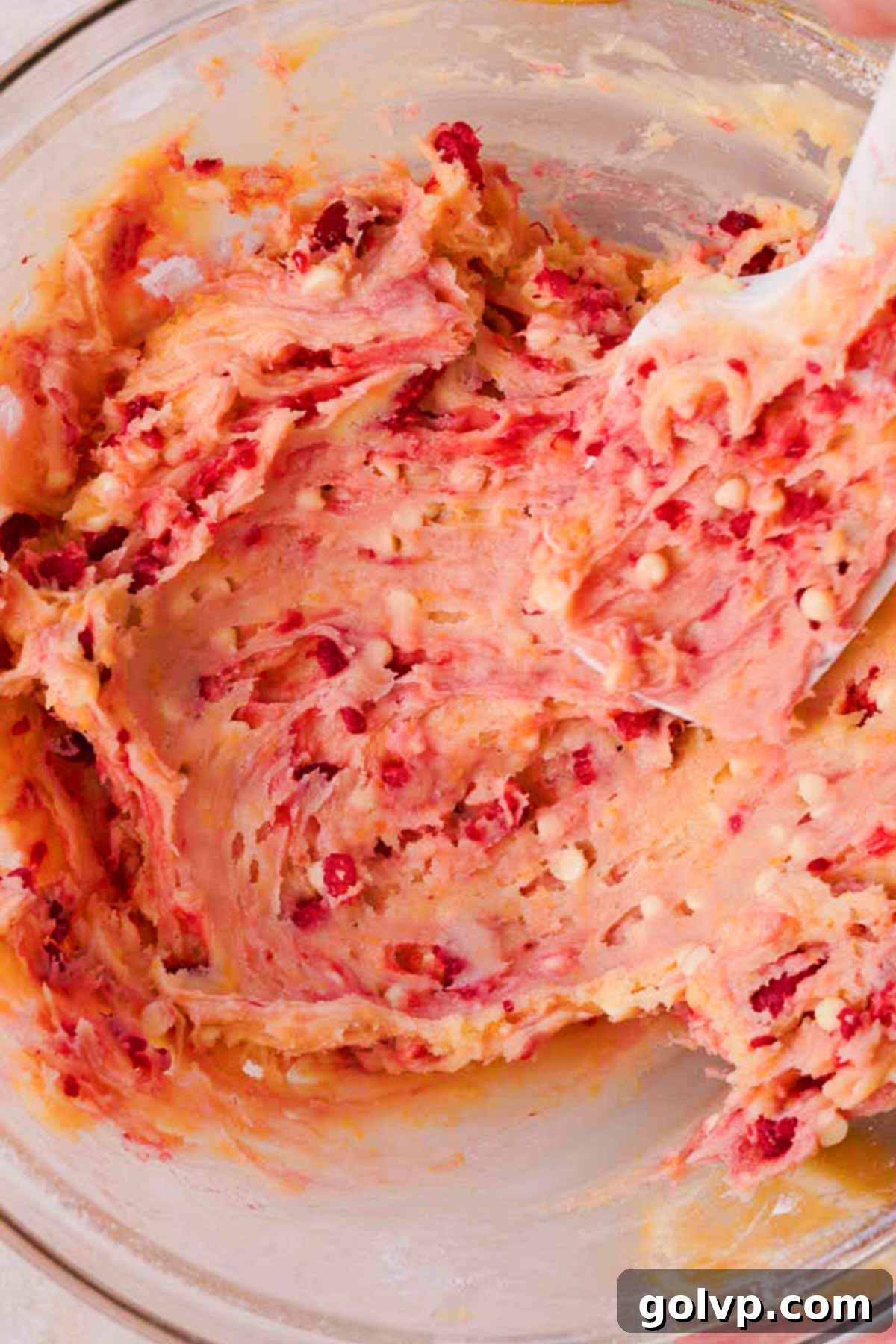
Step 6: Gently Swirl and Mix. With your spatula, gently fold the dough a few times, just enough to incorporate and swirl the raspberries throughout. The goal here is to distribute the fruit and chocolate without completely breaking down the raspberries into a uniform color. You want to see distinct pockets and streaks of vibrant red and white in your dough, which adds to the cookies’ visual appeal. Again, avoid overmixing to preserve those beautiful raspberry pieces.
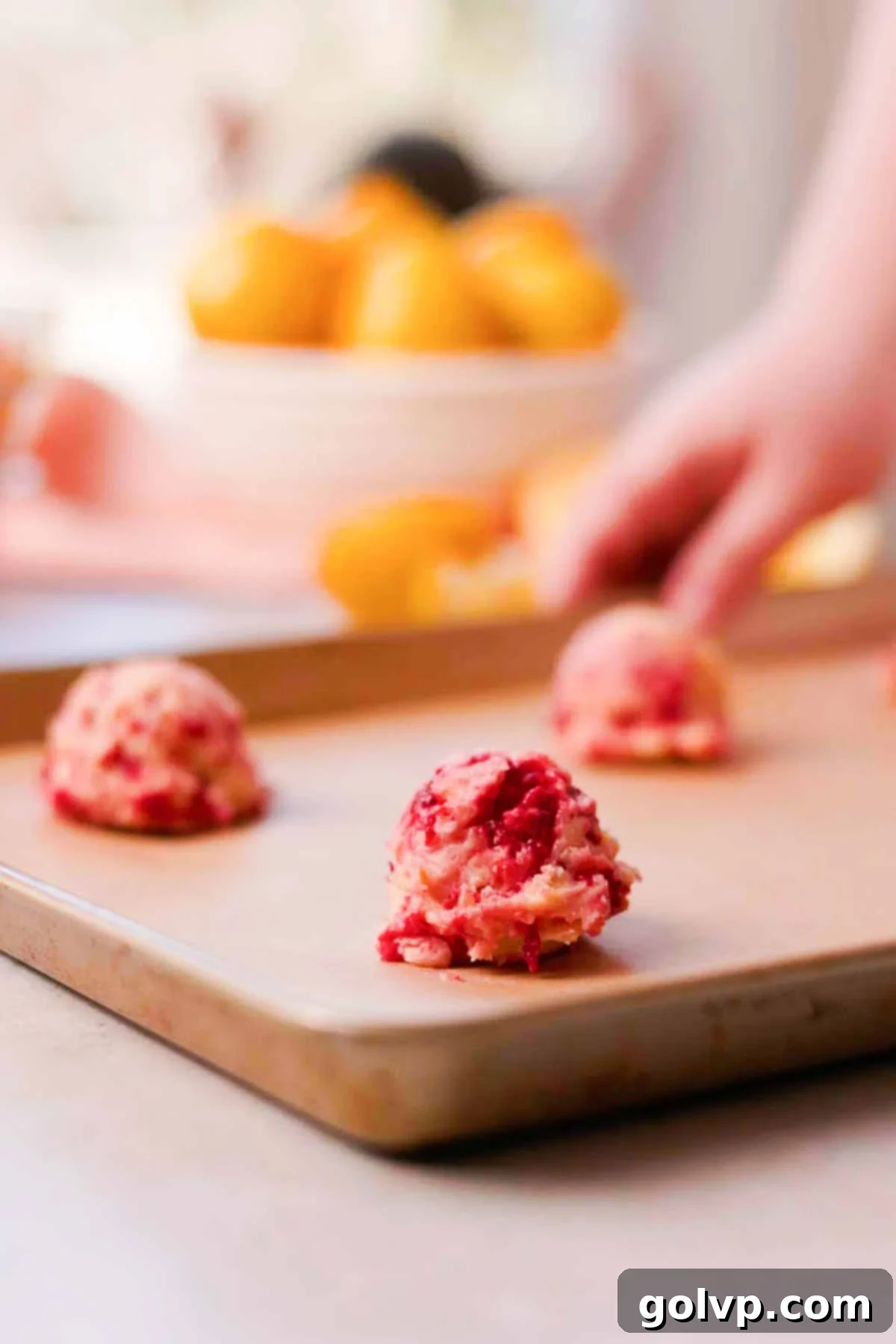
Step 7: Scoop and Bake to Perfection. Using a cookie scoop or two spoons, portion the dough into uniform balls, each about 2-3 tablespoons in size. Arrange these dough balls on your parchment-lined baking sheet, ensuring you leave a generous few inches of space between each. These cookies will spread during baking, so proper spacing is essential to prevent them from merging. Bake for 8-10 minutes. The cookies are perfectly baked when their bottoms are lightly golden-brown, and their middles still appear slightly underbaked and puffed up. This ensures a chewy center. They will continue to set and firm up as they cool on the hot baking sheet.
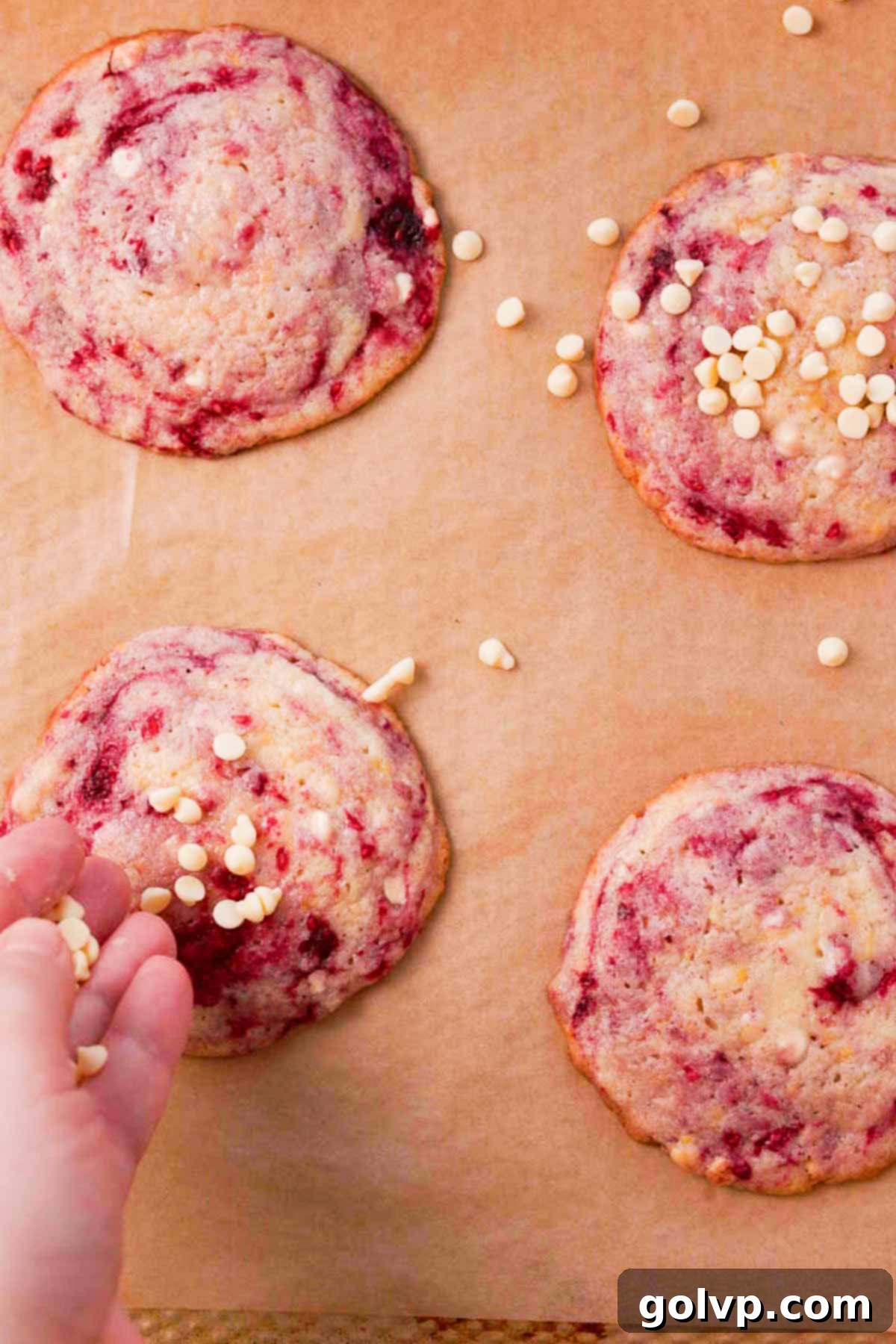
Step 8: Cool and Garnish with Love. Once removed from the oven, immediately transfer the warm lemon raspberry cookies onto a wire cooling rack to cool completely. While they are still warm, gently press the reserved white chocolate chips onto the tops of the cookies. The residual heat will melt them slightly, creating a beautiful, glossy finish. For an extra burst of aroma and visual appeal, grate a little extra fresh lemon zest on top. Continue baking any remaining cookie dough in batches, repeating the process. Allow cookies to cool fully before storing to maintain texture.
📝 Expert Tips for Baking the Best Lemon Raspberry Cookies
Achieving bakery-quality cookies at home is easier than you think with these professional tips. Pay close attention to these small but significant details, and your lemon raspberry cookies will turn out absolutely flawless, delivering on both taste and texture every single time:
- Maximize Lemon Flavor: The Zest-Sugar Rub. This seemingly minor step is a game-changer for intensifying lemon flavor. Before adding any wet ingredients, take a moment to really rub the lemon zest into the granulated sugar with your fingertips or a whisk. The friction helps to release the potent, fragrant essential oils from the lemon peel, infusing the sugar with an incredibly concentrated citrus aroma and flavor. This means a more vibrant and delightful lemon presence throughout every single cookie.
- Precision in Baking: Always Weigh Your Flour. Baking is a precise science, and accuracy in ingredient measurements truly matters, especially when it comes to flour. Weighing your all-purpose flour using a kitchen scale (aim for 270 grams for 2 ¼ cups) is by far the most accurate method and will consistently yield the perfect cookie texture – ensuring they are neither too dense, too dry, nor too crumbly. If you don’t have a scale, remember to measure properly by first stirring the flour in its bag or container to loosen it, then spooning it gently into a dry measuring cup and leveling off the top with a straight edge of a knife, avoiding compacting the flour.
- Prevent Toughness: Don’t Overmix the Dough. Once you’ve added the flour to the wet ingredients, mix the dough just until no dry streaks of flour are visible. Overmixing is one of the most common pitfalls in cookie baking. It overdevelops the gluten in the flour, which can lead to a dense, tough, and less tender cookie texture. A light hand and careful, minimal folding with a spatula are key to maintaining that delicate chew and desired crumb.
- Achieve Perfect Chewiness: Avoid Overbaking! For that coveted combination of soft, chewy middles and slightly crisp edges, it’s crucial to keep a very close eye on your cookies as they bake. The bottom of the cookies should be lightly golden brown, but the centers should still appear slightly puffed up and not fully set when you take them out of the oven. Remember, cookies continue to bake for a few minutes on the hot baking sheet after they’re removed from the oven due to residual heat. Pulling them out at this slightly underbaked stage ensures they’ll be perfectly soft and wonderfully chewy once fully cooled.
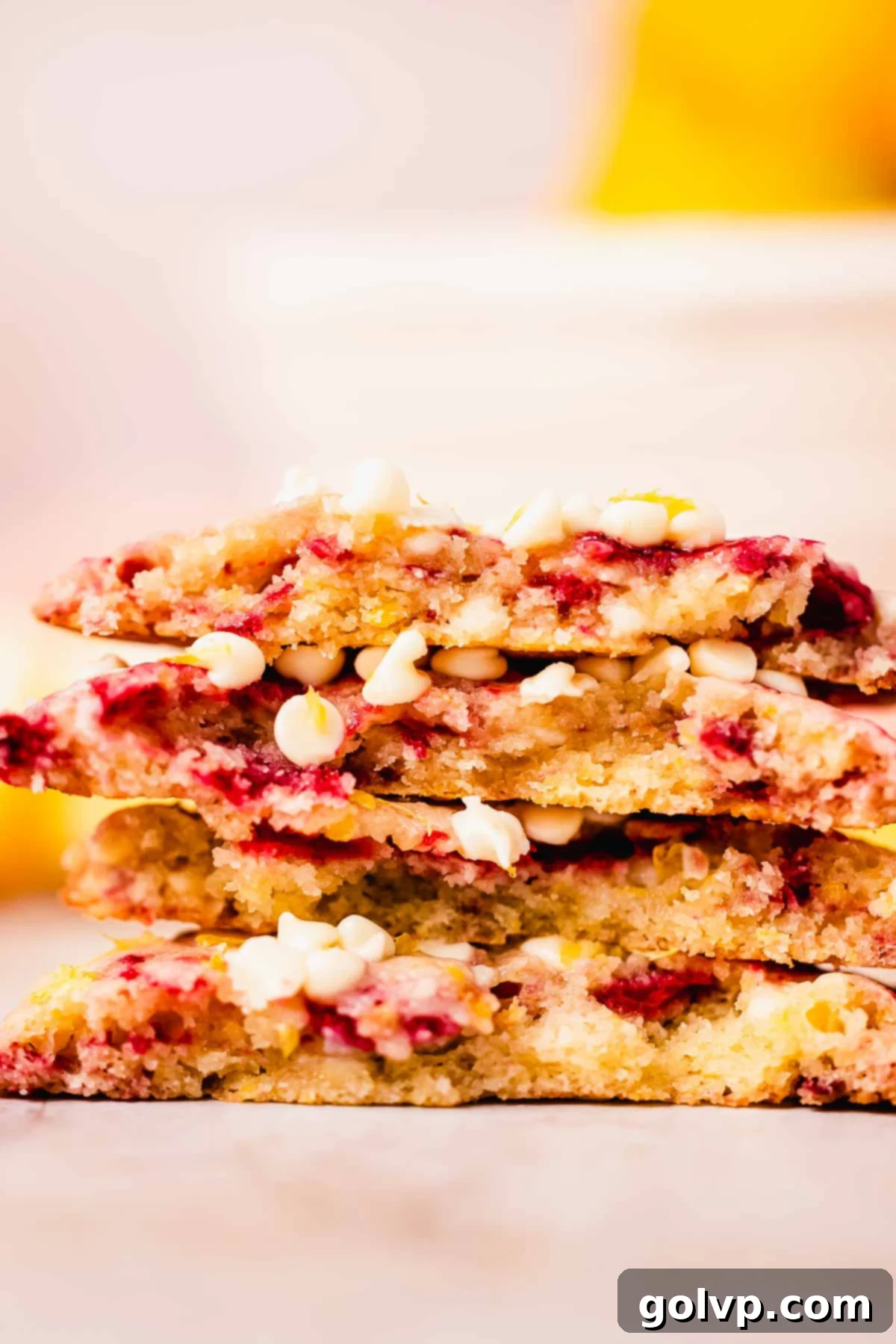
🥄 Make Ahead and Storage for Lemon Raspberry Cookies
Proper storage is essential to ensure your delicious cookies stay fresh, flavorful, and enjoyable for as long as possible. Here’s what you need to know about preparing these particular lemon raspberry cookies in advance and storing them for later enjoyment:
Can You Prepare the Dough Ahead of Time?
Due to the delicate nature and high moisture content of the raspberries within the cookie dough, I generally do not recommend making this particular dough ahead of time and baking it later. If the dough sits for too long, especially when refrigerated, the frozen raspberries will begin to defrost and release their juices into the dough. This moisture release can significantly alter the consistency of the dough, potentially making it too wet, sticky, or even causing the raspberries to disintegrate. This would ultimately affect the final texture and appearance of your baked cookies, leading to a less desirable outcome.
For optimal results and to preserve the beautiful, distinct raspberry swirls and the perfect cookie texture, it’s always best to bake these lemon raspberry cookies as soon as the dough is prepared. The good news is that this is a no-chill recipe, so you can mix and bake immediately! The dough is stable enough to remain at room temperature while you bake several batches, so there’s no real need to chill it.
If you are specifically looking for fantastic make-ahead cookie dough recipes that truly benefit from chilling or store beautifully for future baking, consider trying some of our other popular cookie recipes such as our Lemon Curd Cookies or these delightful Strawberry Cheesecake Cookies. For another excellent make-ahead option where the dough stores exceptionally well in the fridge or freezer, our Brown Butter Toffee Cookies are a perfect choice.
Storing Baked Lemon Raspberry Cookies
Once your lemon raspberry cookies are baked and completely cooled to room temperature, they can be stored in an airtight container at room temperature for up to 3 days. To maintain their freshness, prevent them from drying out, and keep them delightfully chewy, ensure the container is sealed tightly to keep air out.
For longer-term storage, these cookies freeze exceptionally well. Arrange the completely cooled cookies in a single layer on a baking sheet and freeze for about an hour until solid. Then, transfer the frozen cookies to an airtight, freezer-safe container or a heavy-duty freezer bag. They will keep well in the freezer for up to 3 months without any loss of quality. When you’re ready to enjoy them, simply take out the desired number of cookies and let them thaw at room temperature for an hour or two. You can even warm them slightly in a microwave for a few seconds or in a low oven for a few minutes to bring back that freshly baked, gooey center feel.
❔ Can You Chill the Lemon Raspberry Cookie Dough?
While many cookie doughs often benefit from a period of chilling in the refrigerator to develop flavors and improve texture, it’s generally not recommended for this particular lemon raspberry cookie recipe. The primary reason for this specific advice lies in the inclusion of fresh or frozen raspberries in the dough.
As the dough chills, especially if you’re using frozen raspberries, the berries will gradually defrost and begin to release their inherent juices into the surrounding dough. This release of moisture can lead to a few undesirable outcomes:
- Altered Dough Consistency: The excess released moisture can make the dough too wet, sticky, and difficult to scoop or handle. This directly impacts how the cookies spread and bake.
- Compromised Cookie Texture: High moisture content in the dough can lead to a less desirable final cookie texture. Instead of soft and chewy, they might become soggy, overly cakey, or even prevent proper browning and crisping of the edges.
- Disintegrated Raspberries: The raspberries themselves might break down further and lose their distinct shape and vibrant color within the dough. This would result in a more uniformly colored, possibly muddy-looking dough rather than the beautiful, distinct swirls of fruit we aim for.
For the freshest and most visually appealing results, it’s strongly advised to bake these cookies as soon as you prepare the dough. The good news is that this recipe is specifically designed to be a “no-chill” recipe, meaning you can mix and bake without any waiting time. The dough is perfectly stable and will be fine to stay at room temperature while you bake multiple batches. If you are specifically looking for a cookie recipe where chilling the dough is beneficial or a necessary step for make-ahead convenience, please explore our other cookie recipes, such as the brown butter toffee cookies, which are excellent options for preparations that involve refrigeration or freezing the dough.
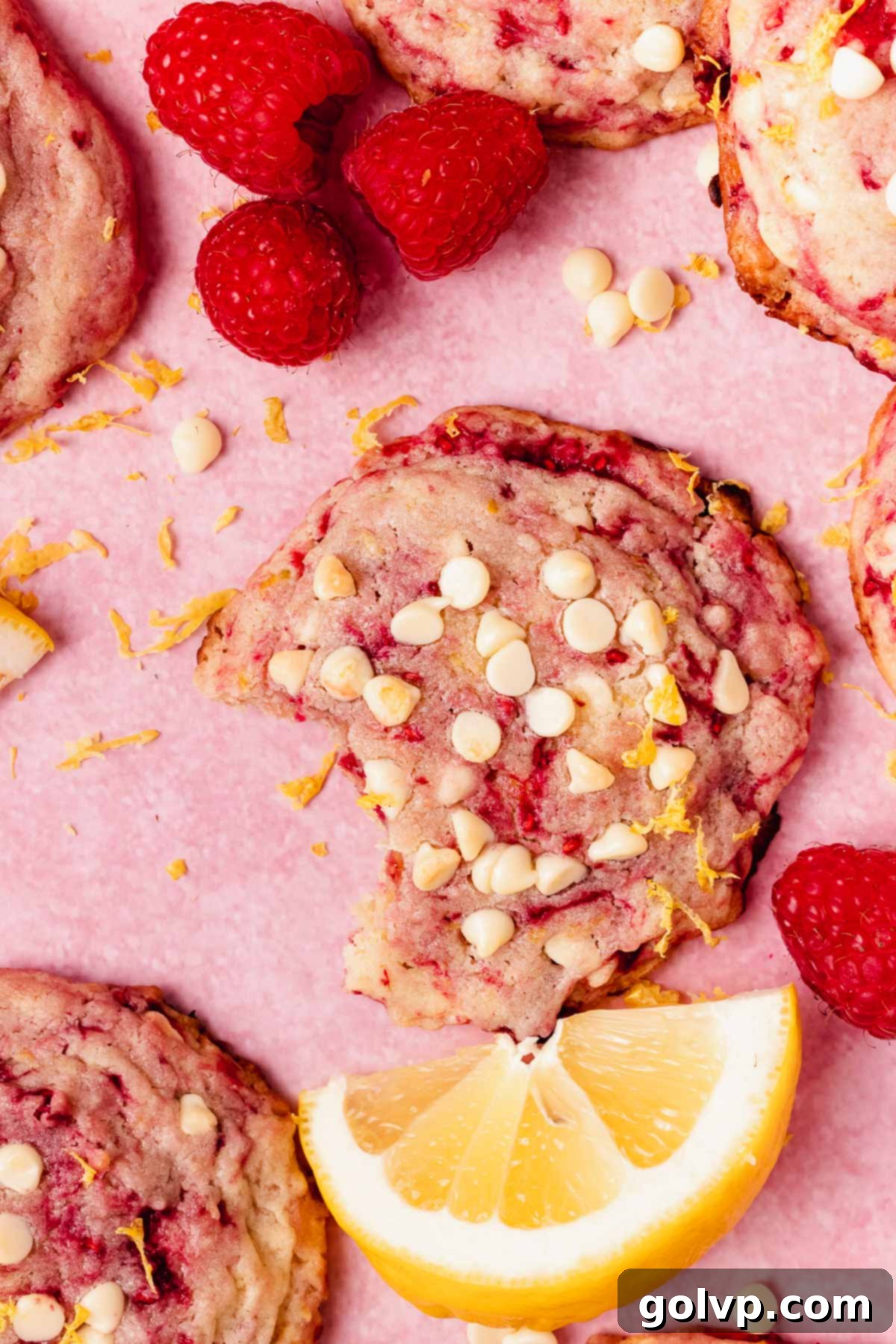
📖 Recipe FAQs for Lemon Raspberry Cookies
Chilling this specific cookie dough is not recommended primarily because the raspberries, whether they are fresh or frozen, will release their natural juices as they defrost or sit for an extended period in the cold dough. This added moisture can significantly affect the dough’s consistency, potentially making it too wet and difficult to handle, and ultimately altering the final texture of your baked cookies. For the best outcome and to ensure distinct raspberry swirls, it is recommended to bake these cookies as soon as the dough is prepared. The dough is stable enough to remain at room temperature while you work through baking multiple batches, so there’s no need for chilling.
While I haven’t personally tested a gluten-free version of this exact recipe, it generally should work well with a high-quality 1:1 gluten-free all-purpose flour blend. When substituting, it’s best to look for a blend that is specifically formulated for baking and often contains xanthan gum to help with structure and binding. Be aware that results may vary slightly in texture and how much the cookies spread, so baking a small test batch is always a good idea to confirm your desired outcome.
Absolutely! If you’re not a fan of white chocolate or simply wish to experiment with a different flavor profile, you can very easily substitute it with semisweet chocolate chips or even dark chocolate chips. A delicious lemon-dark chocolate combination can be incredibly appealing, as the slight bitterness of dark chocolate provides an intriguing and sophisticated contrast to the bright lemon and tart raspberry flavors. You could also chop up a good quality dark chocolate bar for larger, more intense chocolate pockets throughout the cookies.
Yes, you can certainly leave out the white chocolate chips if you prefer a pure lemon and raspberry experience, or if you have specific dietary restrictions or preferences. The cookies will still turn out wonderfully flavorful and delicious, packed with vibrant fruit and citrus notes. The white chocolate simply adds an extra layer of creamy sweetness and a delightful textural contrast, but the essence of the cookie remains strong without it.
While raspberries are specifically chosen for their ideal balance of tartness and controlled moisture content, you can certainly experiment with other low-moisture berries. Frozen wild blueberries, for example, could be a suitable and delicious alternative, as they are smaller and tend to hold their shape well, similar to raspberries. However, I strongly advise against using high-moisture fruits like fresh strawberries, as they release too much water during baking and can easily make the cookies soggy and prevent them from baking properly. If you do decide to try a different type of berry, please let us know in the comments how it turned out – we love hearing about your baking adventures!
While some cookie recipes traditionally call for adding chocolate chips before baking, for these specific lemon raspberry cookies, adding them after they come out of the oven is a strategic and beneficial choice. We found through testing that baking with the white chocolate chips already incorporated sometimes led to very uneven edges, or the chips themselves could slightly burn or become too browned due to their sugar content and the specific baking temperature. By gently pressing the reserved white chocolate chips onto the warm, freshly baked cookies, you achieve a beautifully melted, smooth, and aesthetically pleasing topping, along with more consistently round and even cookie edges. It also gives a lovely contrast of textures.
🍋 More Zesty & Fruity Recipes You’ll Love
If you’ve thoroughly enjoyed the bright and refreshing flavors of these lemon raspberry cookies, we’re confident you’ll adore these other related recipes from our kitchen. Explore more delightful desserts that expertly feature the wonderful combination of zesty lemon and sweet, tart berries!
- Lemon White Chocolate Cookies
- Lemon Shortbread Cookies
- Lemon Raspberry Cake
- Lemon Raspberry Bars
Did you make this recipe? I would love for you to rate this recipe and hear what you think in the comments below! Share your creation on Instagram and tag @flouringkitchen. Follow me on Pinterestto save and for more delicious recipe ideas and baking inspiration.
📖 Full Recipe Card: Lemon Raspberry Cookies

Lemon Raspberry Cookies
MaryEquipment
-
Cookie sheet
Ingredients
- 2 lemons
- 1 cup granulated sugar
- 1 large egg
- 1 large egg yolk
- 1 cup unsalted butter melted and cooled to room temperature
- ¼ teaspoon sea salt
- 1 tablespoon lemon juice freshly squeezed
- 2 ¼ cups all purpose flour 270 g
- ¼ teaspoon baking soda
- 1 cup white chocolate chopped chocolate bar or real white chocolate chips
- ¾ cup frozen raspberries packed
Instructions
-
Preheat the oven to 355°F (180°C). Line a large cookie sheet with parchment paper.
-
Zest lemons into a large bowl. Add sugar and whisk well until the sugar is fragrant and moistened.1 cup granulated sugar, 2 lemons
-
Add egg and egg yolk into the lemon sugar and whisk until thickened and lightened in color. It should fall off the whisk in ribbons, this will take about 30 seconds by hand.1 large egg, 1 large egg yolk
-
Add room temperature melted butter into the same bowl, and whisk just until fully incorporated and thick. Add salt and lemon juice, whisk to combine.1 cup unsalted butter, ¼ teaspoon sea salt, 1 tablespoon lemon juice
-
Sift flour and baking soda right into the same bowl. Fold with a spatula just until no more dry streaks of flour remain.2 ¼ cups all purpose flour, ¼ teaspoon baking soda
-
Add ½ cup of chocolate (reserve ½ cup for topping) and crumble the raspberries into smaller pieces, adding them right into the cookie dough.1 cup white chocolate, ¾ cup frozen raspberries
-
Fold the dough with a spatula, swirling the raspberries throughout the dough. You don’t want to mix too much or you won’t get any distinct pieces of raspberries in the dough.
-
Scoop the dough into 2-3 tablespoon balls. Bake on a parchment lined baking sheet for 8-10 minutes – leaving a few inches of space between each cookie dough ball because they will spread. The bottom should be slightly golden and the middles should slightly puffed.
-
Transfer the cookies onto a cooling rack to cool completely. Top with more chocolate chips and any extra grated lemon zest. Continue baking the rest of the cookie dough.
Notes
- Rub the lemon zest and sugar together to release all the fragrant oils from the lemon and enhance the flavor.
- Weigh the flour: This will give you consistent results and create the perfect texture. If you don’t have a scale, measure properly by stirring the bag and spooning gently into a measuring cup. Scrape the excess off the top with the flat edge off a knife without packing it into the cup.
- Don’t overmix: Overmixing after the flour is added causes a dense, tough texture.
- Don’t overbake: For the perfect chewy texture, the bottom should be slightly golden brown and the middle will be puffed up and not yet set. The cookies will continue to bake out of the oven.
